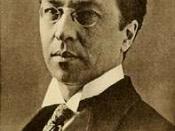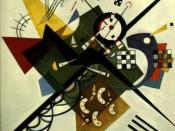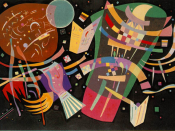HISTORICAL BACKGROUND
Wassily Kandinsky was born in Moscow in 1866 and spent his early childhood in Odessa. He grew up in a cultured family: his parents played the piano and the zither. Kandinsky himself learned to play the piano and the cello at an early age - the influence of music in his paintings later in life was enormous, down to the names of his works Improvisations, Impressions and Compositions.
In 1886 Kandinsky began to study law and economics at the Moscow University and started lecturing at the Moscow Faculty of Law after passing his exams. He had many interests and while he was teaching, he wrote extensively on spirituality, a subject that always interested him and exerted much influence in his work.
In 1895 Kandinsky visited an exhibition of French Impressionists in Moscow including paintings by Monet. He was confused and uneasy when he saw Monet's Haystacks at Giverny, as he believed the artist had no right to paint things in a way that made it difficult to identify the subject.
Soon thereafter, Kandinsky decided to start a new career as an artist and enrolled at the Academy of Fine Arts in Munich for four years, studying life-drawing, sketching and anatomy.
Ironically, Kandinsky's work moved in a far more abstract direct than that taken by the Impressionist works which he had formerly rejected. Kandinsky had seen an Islamic art exhibition in Munich in 1910 - a highly decorative art style where images of humans were not allowed to be shown. Undoubtedly, these works had impacted on Kandinsky because later that year he created his first abstract painting. Before long he began to realise the constraints the art school placed on itself and so he began exploring his own idea of painting. His abstract works established themselves rapidly from 1903,


